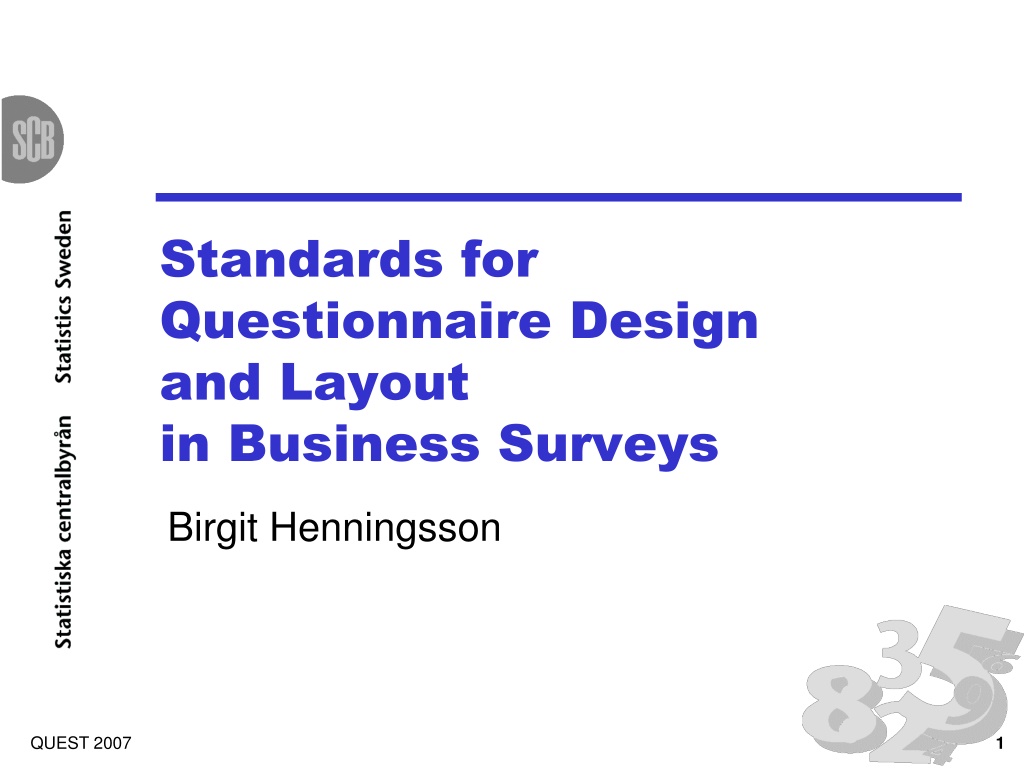
Business Survey Questionnaire Design Guidelines
Explore the comprehensive standards and guidelines for designing and improving business survey questionnaires. Learn about reducing errors, enhancing respondent experience, and refining economic statistics for more effective data collection. Access valuable insights on questionnaire layout, question design, and survey evaluation methods to ensure improved data quality.
Download Presentation

Please find below an Image/Link to download the presentation.
The content on the website is provided AS IS for your information and personal use only. It may not be sold, licensed, or shared on other websites without obtaining consent from the author. If you encounter any issues during the download, it is possible that the publisher has removed the file from their server.
You are allowed to download the files provided on this website for personal or commercial use, subject to the condition that they are used lawfully. All files are the property of their respective owners.
The content on the website is provided AS IS for your information and personal use only. It may not be sold, licensed, or shared on other websites without obtaining consent from the author.
E N D
Presentation Transcript
Standards for Questionnaire Design and Layout in Business Surveys Birgit Henningsson QUEST 2007 1
Why? Questionnaires potential source of errors Reduce respondent burden Improve economic statistics Reduce the amount of editing This means improved questionnaires are necessary QUEST 2007 2
Tasks Guidelines for design of questions Visual guidelines for questionnaire layout Enterprise characteristics that affect measurement Editing staff debriefings Process data in web questionnaires Studies of response process Model for studying data availability Create cyclic model for systematic development and review Checklist for evaluation - expert review Use nine surveys that were chosen by the editing project QUEST 2007 3
Cyclic Model Define the Survey Questionnaire Design Testing Data collection Evaluation New round QUEST 2007 4
Questionnaire Design Gathering of knowledge Types of questions Response alternatives Languages Definitions and instructions Order of questions General advice and guidelines for writing questions QUEST 2007 5
Enterprise characteristics Differences to household surveys Response process The right person Statistical units Terms and definitions QUEST 2007 6
Checklist for expert review General things Covering letter and instructions Questionnaire Structure in the questionnaire Formalities Visual layout Tables Questions Response categories QUEST 2007 7
Visual layout Large effect on the data process Application of existing principles Questionnaire flow Standardized survey information Adaptation to scanning possibilities Cover letters Visual examples of standard questions and extracts of the nine surveys QUEST 2007 8
a) Hur m nga l genheter av varje typ finns i huset/husen ? b) Hur f rdelas antalet kvadratmeter p respektive l genhetstyp? c) Hur stor r summan av alla rshyror/avgifter f r respektive l genhetstyp? ** d) Hur stor r summan av insatser f r bostadsr tter/ kooperativa hyresr tter? e) Hur m nga l genheter var outhyrda/ os lda den 31 december 2005? L genhetstyp OBS! ndra inte p indelningen nedan. rum r knas som ett rum Ange antal Ange hela kvadratmeter Svara i kronor Svara i kronor Ange antal 011 012 013 014 015 1 rum och kokvr . 021 022 023 024 025 1 rum och k k 031 032 033 034 035 2 rum och k k 041 042 043 044 045 3 rum och k k 051 052 053 054 055 4 rum och k k 061 062 063 064 065 5 rum och k k. 071 072 073 074 075 6 eller fler rum och k k vriga l genhetstyper (ex. kokvr med fler n 1 rum) 081 082 083 084 085 091 092 093 094 095 Summa samtliga l genheter QUEST 2007 9
QUEST 2007 10
Editing Staff Debriefings Qualitative method to use experiences from the production process Four debriefings made within project Summary of results and findings, place method in cyclic model QUEST 2007 11
Topic Guide Start with the aims of the debriefing Ask the supervisor to describe the editing process In what different ways does the respondent answer the questions? (web, paper, a file) What reactions do you have from the respondent? Are there any problems with the variables in the survey? What are the reasons to the problems? Does the respondent use the instructions? What kind of business has problems? Do you need further improvements in your system? QUEST 2007 12
Results You will have a lot of information Can point out in the questionnaire where the problems are Often know the reason for errors You can use the method as a complement to cognitive test A complement to quantitative methods process data QUEST 2007 13
What's left after the project? Tests with actual respondents Create finished guidelines, templates Use results from this and other projects to finalize a complete cyclic model QUEST 2007 14
